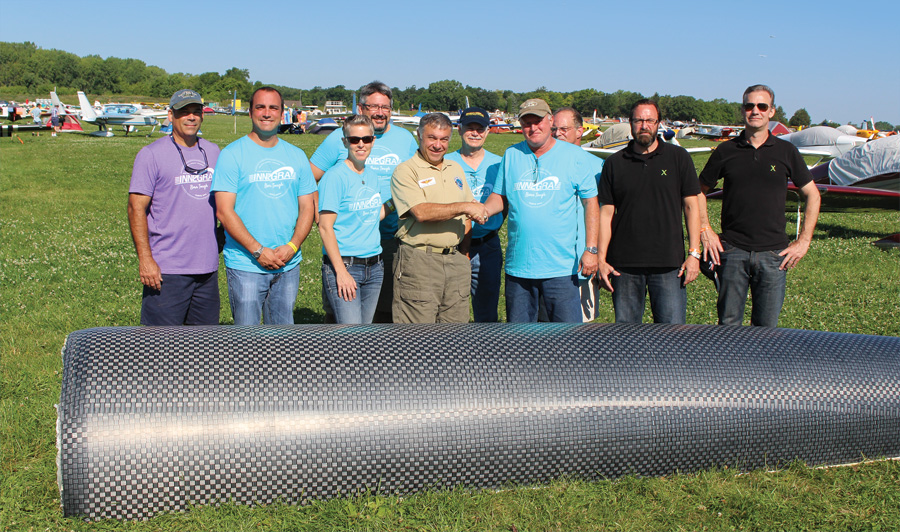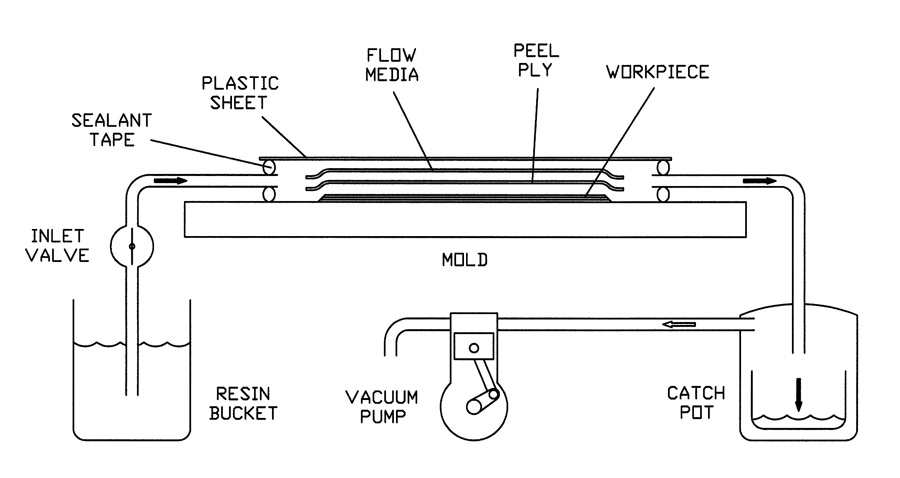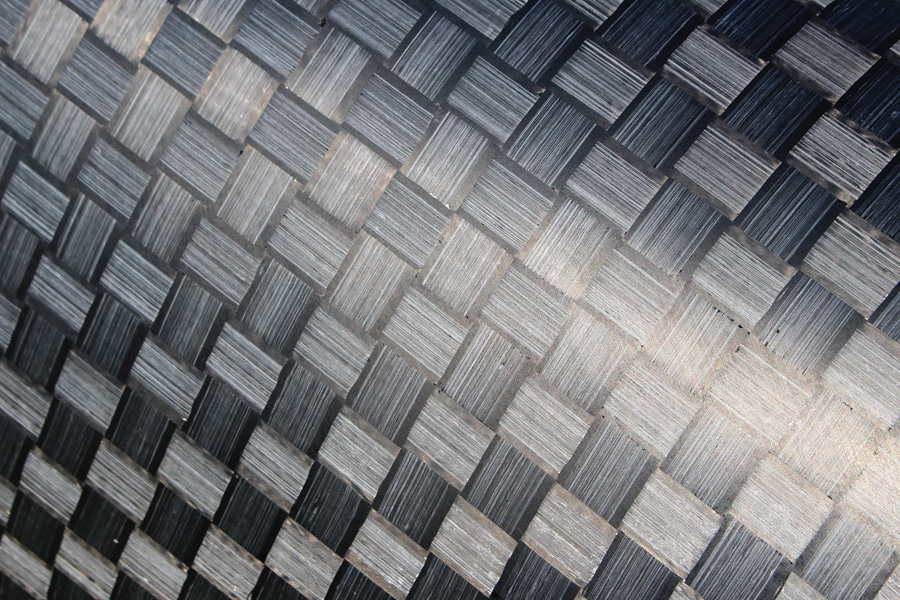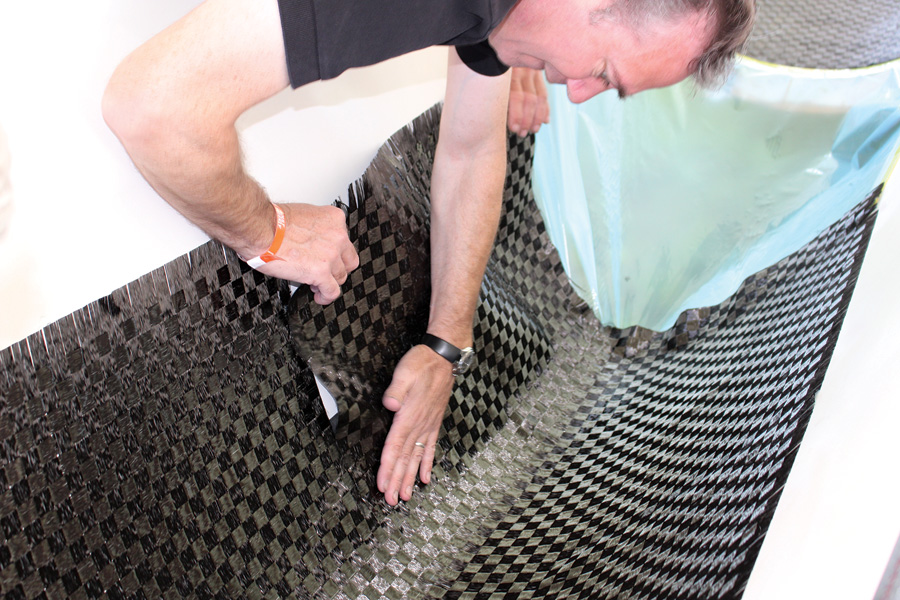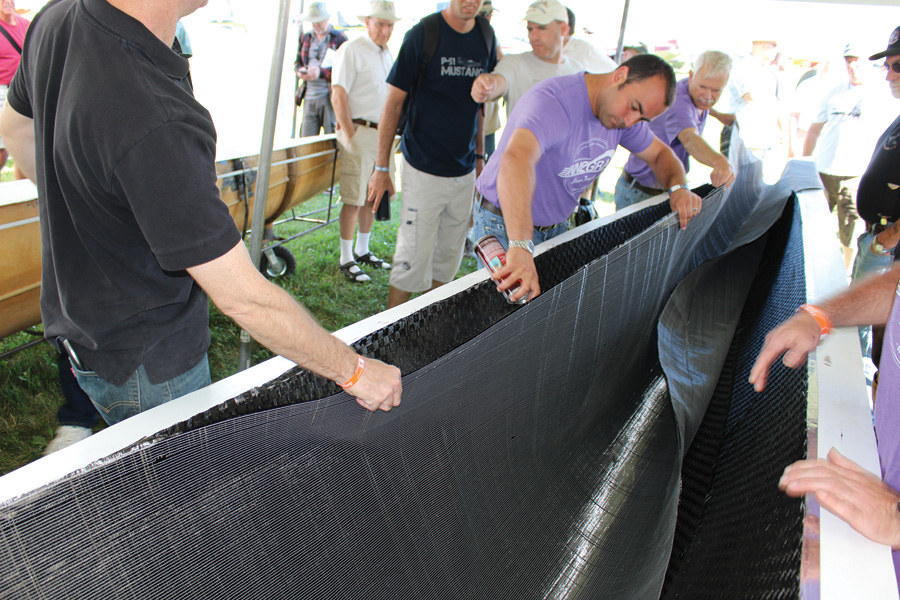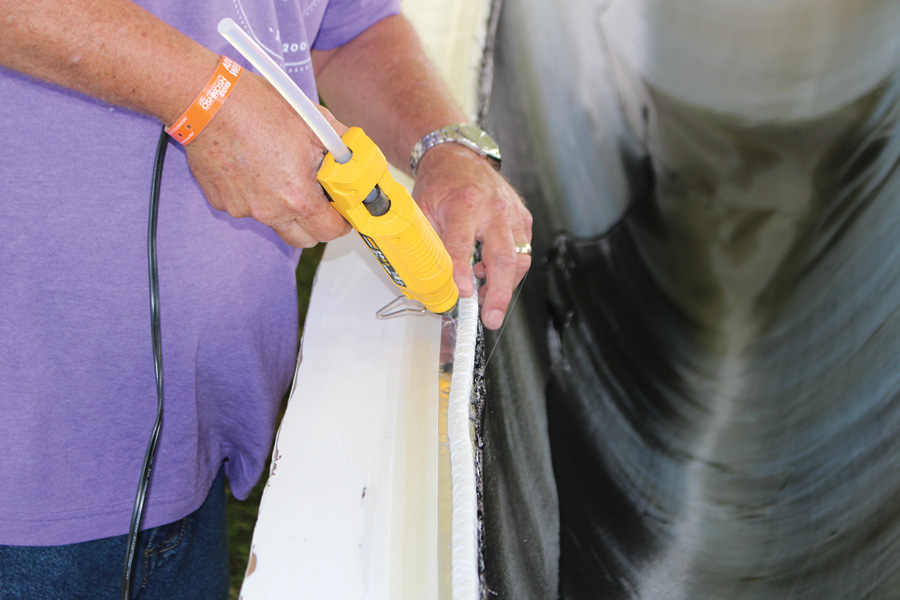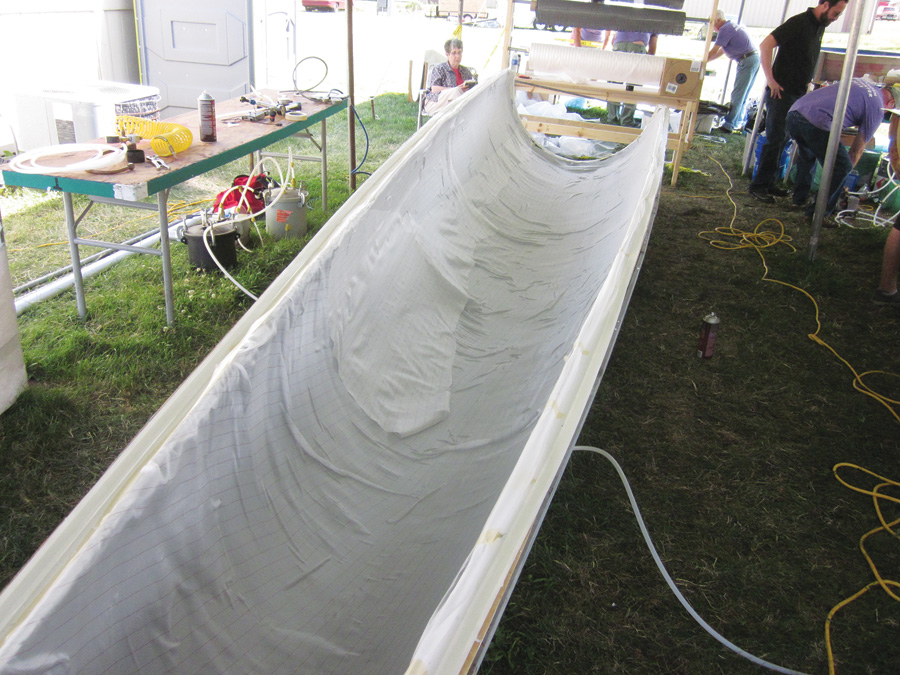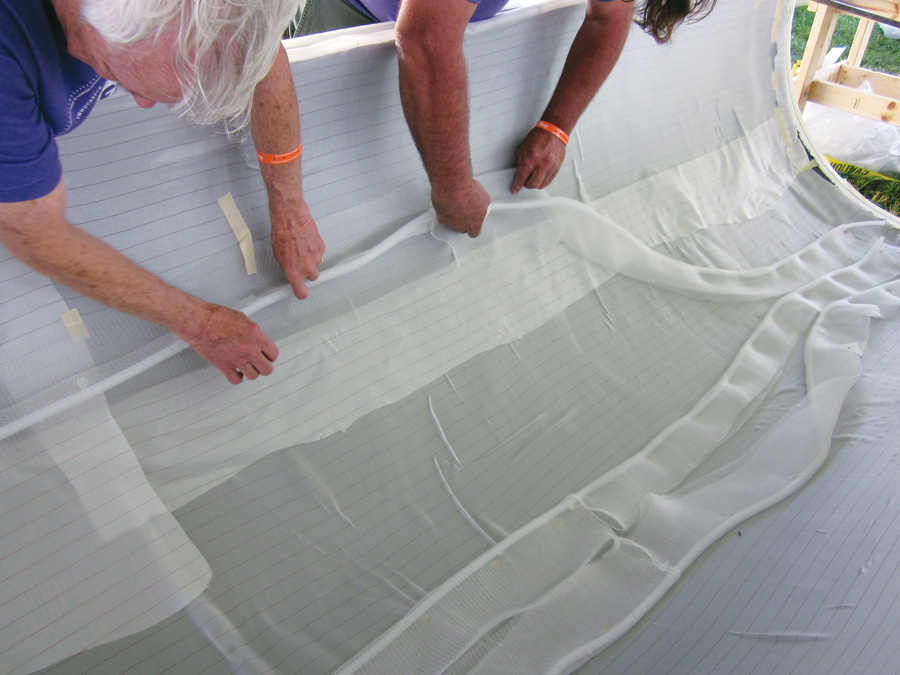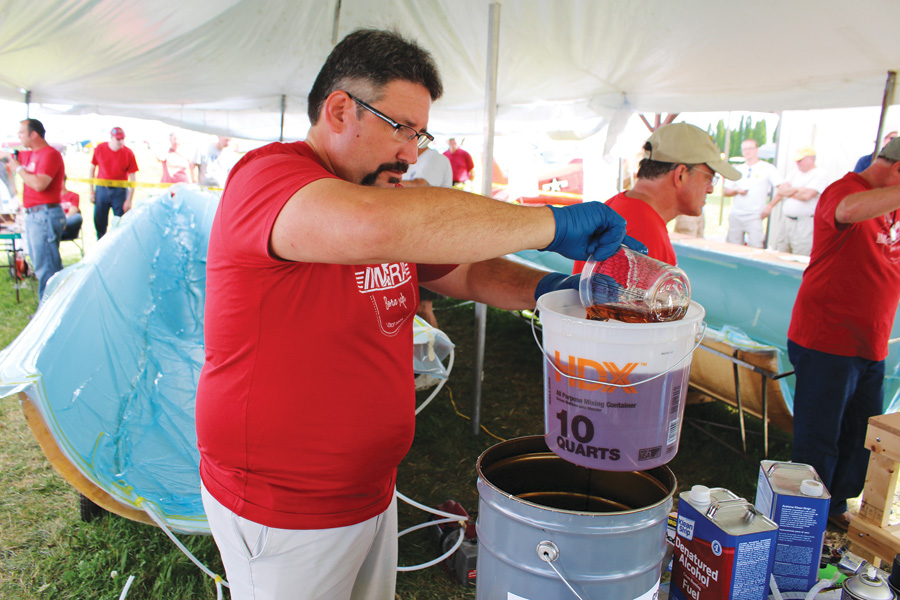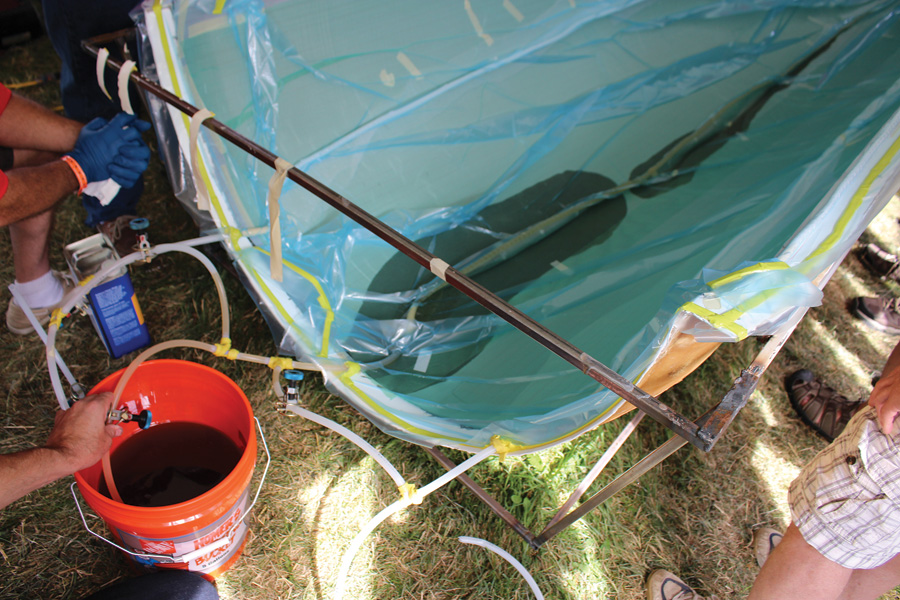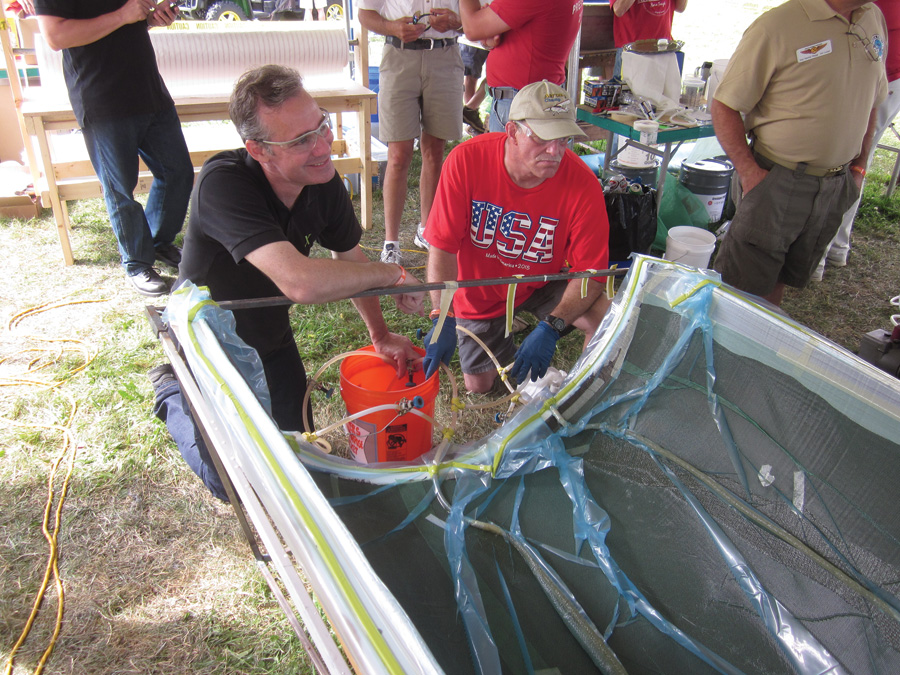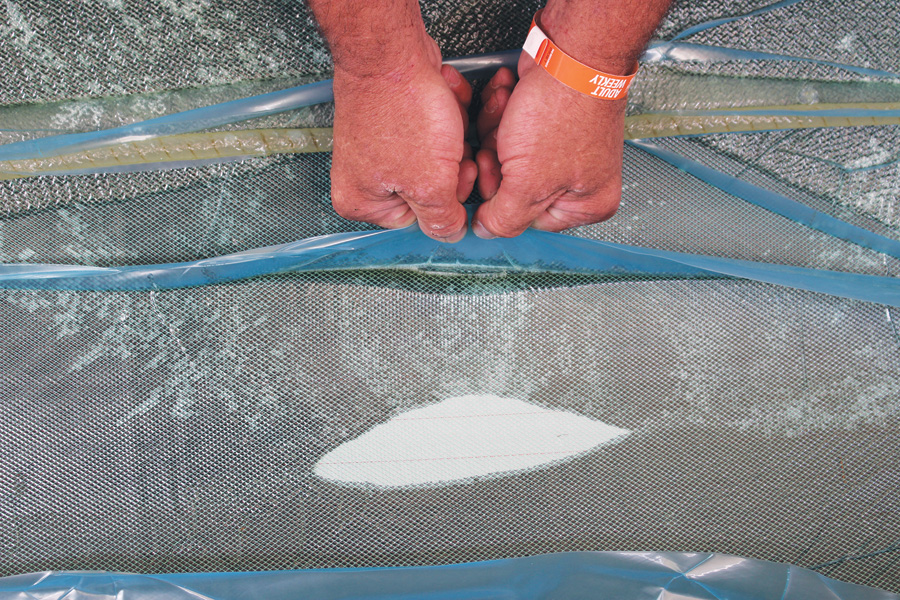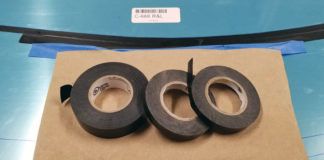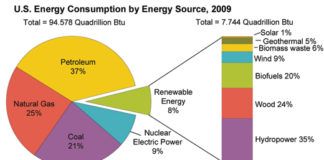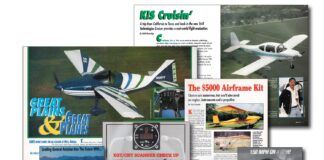The Infusion Gang, L to R: Dean Bugner, Innegra; Brian Gardner, Sigmatex; Jan Hanna, Innegra; Jeff Starcher, Scott Bader Co.; Tony Piaggi, lucky Corsair builder; Jimmy Carter, homebuilder; Russ Emanis, Innegra; Steve Spence, Lockheed Martin; Mark Shioleno, TeXtreme; and Jim Glaser, TeXtreme.
In the beginning, there was Rutan. The 1975 arrival of the VariEze at Oshkosh introduced homebuilders to structural composite construction and spawned a flood of new designs. The fundamental method remains popular; foam cores are hot-wired to shape, then covered with glass or carbon fabric. Epoxy resin is applied to the fabric using brush and squeegee, and worked into the weave until it appears to be saturated. Exactly how saturated is a key part of the learning curve. Too much epoxy and the finished part is heavier than necessary. Too little epoxy results in a loss of strength. An acceptable resin-to-glass ratio for wet layup is generally thought to be about 50-50, but the target can be hard to hit. In this detail, the simplicity of wet layup is both a blessing and a curse.
The next evolution, vacuum bagging, went a long way toward eliminating the resin ratio problem. The fabric is positioned and saturated in the usual way, while purposely erring toward resin-rich. Saturation is immediately followed by bagging. First, a peel ply layer is squeegeed onto the wet surface, followed by a bleeder ply, then the entire layup is covered by an airtight plastic sheet. The plastic can be a bag enveloping the entire component, or it can be a single cover sheet sealed around the perimeter of a mold. In either case, a vacuum line is attached, and a pump evacuates the bag. Atmospheric pressure squeezes the layup, consolidating the fabric layers and forcing out excess resin, which passes through the peel ply for capture in the bleeder ply. The vacuum is maintained until the resin solidifies, and after cure, the bag, bleeder ply, and peel ply are removed and discarded. The result is a leaner resin-to-fabric ratio, without an appreciable loss of strength. Squeezing the fabric plies together simply leaves less void space for epoxy.
Resin infusion is a natural progression. The difference is that the fabric plies are placed in the mold dry, and remain dry, while the vacuum bag is assembled. After the bag is sealed, vacuum is applied, and the dry layup is compacted. Only then is resin allowed to enter the bag through an inlet line. Differential pressure forces the resin to flow across the mold and through the fabric plies, saturating them with just enough resin to fill the voids between individual fibers. When the resin flow reaches the outlet, the inlet is closed with a valve, and as with ordinary bagging, vacuum is maintained until the resin solidifies.
Figure 1. Very basic resin infusion setup. Following dry assembly, atmospheric pressure forces resin through the fibers.
Why Do It?
There are quite a few advantages to using the infusion process, and of course a few negatives. Let’s take a look.
As compared to conventional wet bagging, most users report a slightly better resin-to-fiber ratio. The key appears to be better fiber compaction. The fabric is squeezed while dry, rather than after saturation with a viscous resin, so there is no need to squeeze excess resin out of the layup. An operator is not required to judge saturation, a big factor when working with an opaque fabric like carbon, and there are no variations between different operators. Although infusion has some additional setup cost, the uniformity can save money when working with large layups, because the process is so predictable. For example, if you know how much resin was drawn from the bucket to saturate a top right wingskin, you know exactly how much to mix for the next three skins.
A builder who likes his shop clean and neat will love infusion. The process introduces resin into the layup directly from the mixing bucket, via a plastic line, which eliminates drippy brushes and cups, and mixing of multiple small batches. It’s also a lot safer, as it limits skin contact, and the chance of developing a chemical sensitivity. Vapor exposure is also reduced, a significant factor if the resin choice includes a risky ingredient.
Finding an air leak quickly can be a frantic experience with wet layup bagging. Resins have a gel time, and once mixed, the clock is running. Resin must be applied, worked into the fabric, bagged, and placed under vacuum before the gel time expires, or the whole setup is wasted. In contrast, infusion introduces no resin until after the bag is shown to be air tight. As much time as necessary can be spent chasing leaks; the bag can even be modified or dismantled if necessary.
Actually, unlimited setup time is probably the best reason to consider infusion for the home shop. Traditionally, composite builders have been forced to do large layups in work sessions with friends, as mixing, saturation, and bagging is often more than one person can do within the available resin gel time. Scheduling those friends can really delay a project. Using infusion, a homebuilder can prepare a mold, lay fabric plies, and then bag and vacuum check the layup over the course of many days, working entirely alone in work sessions of any length. When ready, he can also do the infusion without help, but his friends will probably come over to watch and offer high-fives.
So what’s not to like? First, understand that infusion success is entirely dependent on the setup, and every mold is different. The first attempt (or perhaps the first several) may fail. Although general principles always apply, trial and error may be required to determine the best placement for inlet and vacuum lines. Get it wrong, and the resin, which flows in a more or less direct path from inlet to outlet, will bypass an area. You’ll need to modify the setup and try again.
Familiar materials may require new thinking, and there will be new materials. For example, infusion is generally faster in loose weave and continuous fiberglass plies, and slower in tight weaves, or carbon and aramid fabrics. The bag setup may need to be adjusted for the different flow rates. Many reinforcement fabrics will require the addition of flow media, a ply which can be incorporated as a permanent core in the laminate, or as a disposable spacer added to the top of the laminate stack. If added as core, flow media may require engineering review by the aircraft’s designer.
Resin choice may be the biggest change. Experienced homebuilders tend to become familiar with a resin system and stick with it (pun intended) forever. However, the popularity of infusion in commercial production (notably boat hulls and wind turbine blades) has spurred the development of low-viscosity structural resins designed for free flow. Compared to typical laminating resin, these infusion resins may seem like water. A builder may be uncomfortable when faced with unfamiliar labels and new mixing ratios.
The end result: Here’s the surface of the laminate after removal from the mold. Note lack of voids and bubbles. Black fibers are carbon, white fibers are Innegra olefin.
A Typical Infusion Setup
Although not strictly required, most resin infusion is done in a prepared mold. Building plugs and molds is beyond the scope of this article, so for now, merely note the Golden Rule of Moldmaking: Time spent creating a perfect mold pays a huge dividend later.
After cleaning, sealing, and the application of a release agent, the first fabric reinforcement ply is laid into the mold. Unless the mold is flat, the fabric will try to slide around and pile up in the bottom. To tack the fabric into place, the mold can be dusted with a very small quantity of 3M Super 77 spray adhesive where required. Used in small amounts, it won’t interfere with the resin bond. Second, third, and subsequent reinforcement plies are stacked in the mold just like the first, again using very small quantities of spray adhesive as necessary. Depending on laminate design, one of the intermediate plies may be a flow media. The layup is finished by adding the disposable plies, starting with a peel ply or release ply. A flow media will probably top off the ply stack, if one was not incorporated into the laminate.
The arrangement of resin supply and vacuum tubes must be carefully considered if resin is expected to flow to all areas of the laminate. Supplying resin at individual points won’t work. Instead, resin is introduced through a spiral cut plastic tube, which extends across the entire length of the mold. Resin fills the tube, then flows out through the spiral cut all along the length in a relatively even fashion. To improve flow in the immediate area of the tube, it can be wrapped in a strip of flow media before placement.
Vacuum tubes are placed around the mold perimeter, parallel to the supply tube(s). The sections of vacuum tube that will be imbedded inside the bag are also spiral cut. There are two types, bare tube, and Membrane Tube Infusion (MTI) hose, which adds a two-part sleeve of non-woven bleeder ply material and a semi-permeable membrane around the cut plastic core. Plain spiral cut will allow excess resin into the tube itself, where it will flow toward the vacuum pump. MTI hose attempts to block this flow; the membrane is very similar to common Gore-Tex fabric, which passes gas molecules, but not liquid.
The allowable distance between the inlet and outlet tubes is governed by how easily the resin can flow through the combination of materials in the laminate. A typical distance might be two feet, but can be more or less. A small mold may work well with the resin inlet tube along one edge, and the vacuum tube on the opposite edge (Figure 1). If the mold is four feet wide or less, a single inlet tube laid along the centerline may work well, as resin will flow toward both perimeter vacuum tubes simultaneously. Wider molds may require multiple parallel inlet tubes. Resin is supplied via the first until flow reaches the second. The first tube is then clamped off at the source, and resin is supplied through the second tube, from where it can flow an additional distance toward the outlet. The infusion setup can be constructed with as many parallel inlet tubes as necessary, so that resin is never required to flow an unreasonable distance from any one supply tube.
With the laminate and disposable components in place, everything is enclosed under the plastic bag layer. The perimeter is sealed to the mold surface with sealant tape. The spiral cut resin and vacuum tubes are connected to seamless tubes, which exit the bag at sealed points in the perimeter. Inlet tubes extend to the resin bucket. Vacuum tubes run first to a catch pot, then to the vacuum pump. The catch pot captures resin flowing from the mold before it can reach (and ruin) the vacuum pump.
Let The Fun Begin!
Start the vacuum pump, and give it time to evacuate the bag. Make sure the system pulls a full 29 inches Hg, or close to it. Less indicates a vacuum leak, which will need location and repair. There is no rush; many experienced fabricators feel additional time spent under vacuum (prior to introduction of resin) is beneficial. It tends to remove solvents and moisture from the laminate, and offers an opportunity to inspect for folds, bridging, and slipped fabrics.
When everything is ready, mix the resin. Submerge the end of the inlet hose in the bucket, and open the inlet valve. Make sure the end of the hose does not rise above the surface of the resin and suck air during the infusion. Watch the resin fill the spiral cut inlet hose, then flow out into the surrounding strip of flow media, then into the laminate and creep toward the vacuum line. When the laminate is saturated across the full width of the mold, close the inlet valve. Allow the vacuum pump to continue running until the resin cures to solid.
There isn’t much cleanup. Cured resin in a smooth, clean plastic mixing bucket may just pop out. If the catch pot was prepared with a mold release agent prior to use, any cured resin there will also pop out. Salvage all valves and fittings. The plastic lines, peel ply, external flow media, sealant tape, and bagging film are simply thrown away.
Just Do It
Remember, we build our own airplanes for education and recreation, just like it says in the rulebook. Next time you need to build a composite panel, set your brush and squeegee aside, and give infusion a try. You’ll surely learn something, and that’s always fun.
Oshkosh Infusion Demonstration
Builders had a unique opportunity to see a live demonstration of resin infusion during AirVenture 2015. The demo was a cooperative effort by a group of industry professionals, each contributing materials and knowledge. The result was a set of very light, non-structural fuselage shells for a scale F4U Corsair.
Corsair builder Tony Pileggi supplied the molds. Here composites pro Jim Glaser lays the first of three plies, 130gsm TeXtreme spread tow. It’s a mix of carbon and Innegra olefin fibers. Carbon is stiff, strong, and brittle. Innegra adds fracture toughness (among other properties), a nice marriage.
Second ply, heavy-duty 400gsm Sigmatex non-crimp 12K carbon. 3M Super 77 spray adhesive is used to tack the plies into place, in an otherwise dry mold. The third ply, a conventional 200gsm 0-90 plain weave carbon from Saati Composites, went into the mold in a similar fashion.
Hot glue gun is used to attach MTI (Membrane Tube Infusion) vacuum hose to the perimeter of the mold. It only needs a dab here and there, just enough to keep it in position until…
Next the resin inlet lines are added to the stack. Three spiral cut plastic hoses are wrapped in a strip of plastic mesh flow media. One hose is placed in the bottom of the mold, and the other two are placed about halfway up the mold wall. They’re tacked into place with ordinary masking tape.
Next is a ply of green plastic mesh flow media, followed by the bagging film. The bag is sealed all around the mold perimeter with yellow sealing tape. Non-perforated inlet and vacuum hoses are joined to the spiral cut hoses inside the bag, and the exit points are also sealed with tacky tape. Vacuum pump on, no leaks found…we’re ready!
Jeff Starcher, from resin supplier Scott Bader Company Ltd., serves as mixmaster. This is Crestapol 1250LV, a tough, low-viscosity urethane acrylate resin designed for carbon fiber infusion. It is hardened with an MEKP catalyst, Triginox 239. Gel time at 77F is 37 minutes, which tells a lot about how quickly the laminate will be infused.
And we’re off! The center inlet hose is submerged in the resin bucket, the valve is opened, and atmospheric pressure forces resin into the mold.
Everyone loves it when a plan comes together. TeXtreme’s Jim Glaser, manning the bucket, allowed the flow to move up the sides to the midline inlet hoses before opening their feed valves. The flow easily continued up the sides toward the MTI vacuum hoses. Here it’s almost to the top.
There were a few dry spots, but these guys had a trick. Just pull and release a fold in the bagging film to “pump” resin into the dry area. Experienced operators may also use a vacuum needle (a small probe connected to the pump tubing), which can be poked through the bag to focus vacuum on a dry spot. As the probe is withdrawn, the hole is sealed with a bit of tacky tape.

